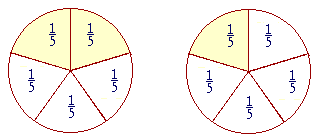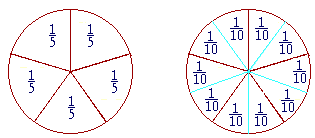|
Example 1.
| Half of |
6
7 |
is |
3
7 |
. |
|
Take
half of the numerator. |
| |
| A third of |
6
7 |
is |
2
7 |
. |
|
Take a third of the numerator. |
| |
| A third of |
4
7 |
is |
4
21 |
. |
4 does not have a third part. Therefore multiply the denominator by 3. |
|
Example 2. How much is a fifth of |
1
2 |
? |
| Answer. |
1
10 |
. Multiply 2 by 5.
|
|
Example 3. How much is half of |
1
10 |
? |
| Answer. |
1
20 |
. Multiply 10 by 2.
|
|
Example 4. |
1
8 |
is which part of |
1
2 |
? |
| Answer. Since 8 is 4 × 2, |
1
8 |
is the fourth part of |
1
2 |
. |
|
Example 5. |
1
16 |
is which part of |
1
8 |
? What ratio has |
1
32 |
to |
1
8 |
? |
| Answer. |
1
16 |
is half of |
1
8 |
. 16 = 2 × 8. |
1
32 |
is a fourth of |
1
8 |
. 32 = 4 × 8. |
times larger?
Answer. Five times larger. Because 25 is 5 × 5.
| Example 7. Percent. Since |
1
8 |
is half of |
1
4 |
(8 = 2 × 4), |
| and since |
1
4 |
is equal to 25%, then what percent is |
1
8 |
? |
Answer. Half of 25%, which is 12½%. (Lesson 15, Question 7.)
Example 8. A recipe calls for 6¼ cups of flour. You are going to make half the recipe. How much flour will you use?
| Answer. Half of 6 is 3. Half of |
1
4 |
is |
1
8 |
. You will use |
3 |
1
8 |
cups. |
Example 9. The following problem appeared in a recent textbook:
The writer no doubt intend it to be translated as
1
2 |
times what number is |
1
5 |
? |
-- thus making it a division problem:
However, if we make verbal sense of the problem --
1-fifth is half of what number?
-- then the answer is obvious. Just as 1 apple is half of 2 apples, so
1-fifth is half of 2-fifths.
| Example 10. |
3
7 |
are half of what number? |
| Answer. |
3
7 |
are half of |
6
7 |
. |
| Example 11. |
3
7 |
are a third of what number? |
| Answer. |
3
7 |
are a third of |
9
7 |
, which is 1 |
2
7 |
. |
*
|
Consider "Half of |
5
8 |
" -- which we know is |
5
16 |
-- and let us write it in |
symbols as
We now see why we multiply the numerators and multiply the denominators:
It follows, as it must, from what the symbols mean.
| Similarly, Half of |
6
8 |
becomes |
"2 goes into 6 three (3) times."
|
Example 12. How much is a third of |
5
7 |
? How much is two thirds? |
| Answer. |
A third of |
5
7 |
is |
5
21. |
(Multiply the denominator by
3). |
| Two thirds of |
5
7 |
is twice as much as one third: 2 × |
5
21 |
= |
10
21 |
. |
In symbols,
| "Two thirds of |
5
7 |
is |
10
21 |
." |
And so we have arrived where we began (Lesson 25, Question 2), at the formal rule for multiplying fractions:
Multiply the numerators and multiply the denominators.
Please "turn" the page and do some
Problems.
or
Introduction | Home | Table of Contents
Please make a donation to keep TheMathPage online.
Even $1 will help.
Copyright © 2001-2007 Lawrence Spector
Questions or comments?
E-mail: themathpage@nyc.rr.com
|


